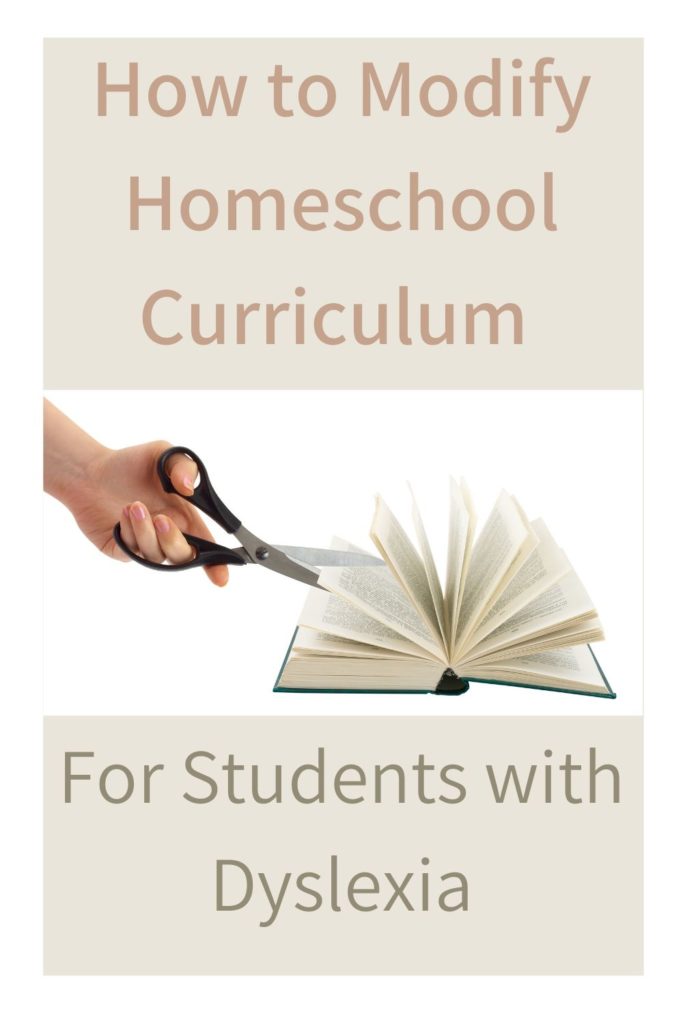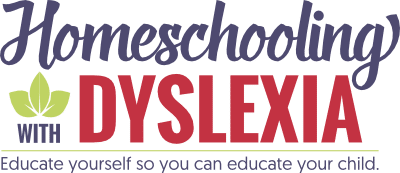There are great homeschool curricula available for kids with dyslexia. But what if buying a new curriculum is not an option? Let’s take a look at some ways you can modify homeschool curriculum for the student with dyslexia.

I recently corresponded with a wonderful mom who is homeschooling her dyslexic children overseas where buying (and sometimes returning) homeschool curricula can be time-consuming and expensive. There are many wonderful options for curriculum but if buying a new curriculum isn’t an option, you can still modify your homeschool curriculum to fit the unique needs of your dyslexic learners.
How to Modify Homeschool Curriculum for Students With Dyslexia
Remember when we talked about How Dyslexics Learn? You will want to read that post so that you can better understand the basics of how to teach in ways that your child learns best. In that post, we learned a little about brain structure, how dyslexics tend to favor the right-brain strengths, and therefore learn with visual, creative and auditory methods.
Start by giving them the big picture
Because people with dyslexia are big picture-oriented rather than detail-oriented, begin by previewing the subject that you are about to teach. Give them a hook on which to hang all of those pesky details. For example, before you begin a study of Ancient Egypt, hit the library and check out some of the fantastic illustrated DK books or something similar. Flip through the pages and talk about the location, look through artifacts from the era and get a bit of the big-picture about Egypt. Take time to review what you are learning as you go and put the new information into context of the big picture. Another example would be to relate what they are about to learn to real life somehow. So when introducing decimals, spend time talking about money and how dollars and cents are separated using decimals.
Read out loud if no audio version is available
If a curriculum that you are using is heavily reading based, read it aloud or have one of your kids who is able, read the selection. Asking a child to read a grade level text when they are not reading at grade level isn’t helpful. Remember that remediation of weak reading skills should not be consuming every moment of your kids day. Save reading for reading instruction.
For more on how to teach reading to kids with dyslexia, read this.
Forcing kids to read beyond their ability will only make all of you frustrated and resistant to doing schoolwork. Do remediate reading with research-based methods but allow your kids the freedom to learn and enjoy their other subjects without the pressure of having every lesson be a reading comprehension and spelling test.
Discuss rather than write
For many dyslexics, writing is painstaking experience. Difficulty spelling and forming letters results not only in frustration, but also in answers that are far below a student’s intellectual ability. Take those review questions at the end of a chapter and discuss them out loud with your students. If time is an issue, pick only a few of the questions. You will be amazed at how much learning and connecting is going on in your student’s mind. Another alternative, especially for middle and high school-aged students is to use a speech-to-text app that can convert their spoken responses into text on a computer or tablet. See our Resources Page for links to some of this type of technology.
Testing comprehension
Another fantastic way to gauge comprehension is to use the gentle art of narration. After reading a passage, have kids tell back what they learned. Ask a few questions here and there to prompt their memory if necessary. Narration is an excellent precursor to wiring as it requires the narrator to organize their thoughts and put them into words much like they would do in a written composition. If your kids struggle with recalling specifics, ask questions to guide their thoughts.
Is attention an Issue?
If attention is an issue, consider shortening lesson times and stretch a chapter out to fit your child’s attention and interest level. To learn more about the connection between dyslexia and ADD/ADHD, read this post. Checking out related DVDs from the library or streaming videos on subjects that you are studying are great ways to supplement learning in the visual method that dyslexics love.
Be creative
Because the dyslexic mind prefers feelings and imagination rather over logic and facts, you will need to be creative. If you have been teaching kids with dyslexia for any amount of time, you already know that they don’t do well with rote memorization. Math facts anyone? Creating stories to help memorize math facts or illustrating spelling or vocabulary words will help these ideas to stick. Utilize anything visual that you can to help fact to stick.
Another excellent way to memorize anything from math facts to Bible verses is to put it to song. With a decent Internet connection, you can access You Tube which has lots of FREE educational songs such as this math facts channel.
Think multi-sensory
Using more than one sense while learning helps information to stick. Consider actually doing a science experiment as opposed to reading about it. Which one would provide a more memorable learning experience? Examples of multi sensory techniques are using math manipulatives for building math problems, letter tiles for building and touching words, electronic flashcard apps such as Quizlet for multi-sensory review of terms. Many hands on teaching aids can be made at home very inexpensively.
On the Resource Pages of this site, I list many of my favorite curricula for using with the student with dyslexia. These curricula utilize methods that fit the general way that dyslexics learn.






This new blog is an answer to prayers. Finally, someone to “talk to” about all the issues we are having. I have three dyslexic sons, and your experiences are invaluable to me.
Fantastic post! I wish all homeschool curriculums had audio versions! I read most things out loud as far as science and history. We are using Exploration Education Physical Science this year and Teaching Textbooks for math. Both of these are computer based with interactive features-allowing for some multisensory input. We use learning ally for books. I would really like to use Oak Meadow’s curriculum next year but I fear all of the reading without an audio format. I may record it myself over the summer.
Sharon – we use Learning Ally as well, but some time ago they cut back significantly on the number of recordings they could produce for us. I too, used to read our entire curriculum aloud to my daughter. But we’ve found a work-around that helps. If you have an adobe account (about $20/year), you can scan text pages (I actually buy used copies to rip apart), upload them to adobe, where you can then convert them to word. And with a bit of manipulation to remove pictures and other hard-to-follow formatting like columns, the text can be read by Voice Dream which is an IPad app with better than usual text-to-speech. It’s been a gift for us this year because now I can work ahead of my daughter in scanning her books and she can read independently with audio for ALL of her texts, which has been great for her confidence. I wish all textbook producers would realize the significant impact that audio has on students with all types of LD’s.
‘Do remediate reading with research-based methods but allow your kids the freedom to learn and enjoy their other subjects without the pressure of having every lesson be a reading comprehension and spelling test.’
I loved that line. Absolflippinglutely.
I created a program so that Prep and Year One teachers teach every child to read and spell as if dyslexic, even if not. So phonemic awareness issues addressed head on, from day 1. Used for dyslexic learners of all ages however, and will be features in the Immunisation Against Illiteracy Campaign next year – showing how to be fully inclusive from the early years. Please do add a Duck Hands seflie:-) Duck Hands are a powerful free tool to rewire brains for reading and spelling.
For those homeschooling please check out the Wiring Brains site – and also the youtube channel. For example Coded Sight Words brain training videos- no more ‘Look, Cover, Say’ – helps modify brain networks. https://www.youtube.com/watch?v=qAE6SXJsoRY
We must include all learners, ensure that they are enjoying learning, and that the process of learning to read and spell does not prevent them from participating in the rest of the curriculum. Which was the point of the ‘read aloud’ paragraph.
Thank you!
Miss Emma
The Reading Whisperer
Love! Here’s a few things making a difference for us this yeay:
We started using apologia young explorer science series chemistry this yr and the every other page Try this has been an amazing way fir my daughter to learn the concepts being taught. Bonus, mom doesn’t have to come up with the experiments! Lol
For ancient civ this year I have picture books for each civ and at least 2 projects for each, some like Egypt have 4/5, to help her retain what she’s learning. Also doubles as art! And a little math, like when it comes go building a Roman wall out of Legos!
Story Cubes have been great this year too. I let her use 2 sets, then she dictates story into recorder app, then I print it out and she corrects for grammar, and cohesion. Easy way for paragraph ‘writing, that she enjoys! And by rewriting final work, she’s working on cursive too, but it’s easy to her.
We have just discovered that our youngest, a freshman, is dyslexic. Her workload this year crushed her and we slowly came to the realization that “I don’t like to read” really means “I’m having lots of trouble reading”. We have always accommodated her “dislike” of reading by getting audiobooks and having her follow along–I go out of my way to only choose curriculum for her based on audio availability. We’ve always also done Charlotte Mason-style learning, so narration has always played a role. We’ll be expanding narration in the fall as her compositions for the last two years have been torture on both of us.